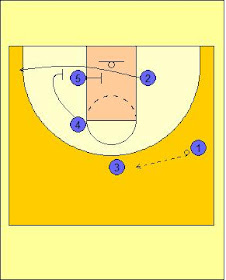According to Leitao, the goal of the motion offense is "you want have an offense that has control and some freedom." The problem though is that motion offense is very good for really skilled players because you can trust them, or very bad for unskilled players because you can't limit them. The offense is based on a series of cuts and stagger screens, attempting to take advantage of mismatches. Forwards are mostly blockers setting screens but also ducking in looking for post-up opportunities. Guards are coming off screens looking for open shots. You can run it as a one and done quick hitter or delay by repeating the motion over and over. The five basic cuts are:
1) Away
2) Corner
3) Chase
4) Swing
5) Shuffle
Away
The idea of the away cut is to run a wing player through the lane. O1 can dribble to or simply pass to the wing, then cuts to the opposite wing. The opposite forward comes up while the opposite wing cuts through the lane looking for the ball, then clears out to the corner,

O2 reverses the ball to O4 then to O1. O5 sets a short UCLA screen for O2 who uses it to cut over top and through the lane looking for the ball,

If neither cut is open, then O4 and O5 set a stagger screen for O3 in the corner. O3 comes off both screens, O1 looks for O3 for the open 3-pointer,

O5 and O4 set another stagger screen this time for O2 who settles into the opposite corner. If O3 is not open, he can dribble/pass to O2 in the corner for the 3-pointer,

Corner
In the corner cut, the guard at the top cuts to corner, same side as the pass to the wing. The goal is to setup a good post-up for O4. O5 comes up to the top of the key,

As the ball is reversed from O3, to O5, to O2, O4 goes block to block looking for a good duck in or post-up,

If O4 is not available, the offense goes into a stagger screen, O3 and O5, for O1 who comes over the top of the stagger and receives a pass from O2 for the open 3-pointer,

Chase
The idea of the chase is like the fill in the DDM. When O1 dribbles towards the wing, O3 shuffles while O2 trails and fills up top. O1 passes to the trailer O2, then O4 comes up to set a screen for O1 who locates on the wing,

There are a series of screens by forwards for guards, O5 sets a baseline flex for O3 looking to curl into a mid-range jumper. O4 screens for O1 coming over the top for an open 3-pointer,

Swing
In the swing, the idea is to get the defense to chase. O1 passes to the wing, O5 sets a UCLA screen, O4 sets a baseline flex, and O3 makes it a stack screen. O1 goes through all the screens and comes out the other side. O2 can dribble/pass to O1. If O1's defender goes over top, then O1 can flatten out for the open jumper in the corner. If O1's defender trails all screens, then O1 should be able to come up to the free-throw extended for an open jumper. If the defense switches everything, then O4 and O5 should have mismatched post-up opportunities,

If nothing develops, O5 steps out to set a ball screen for O2 to drive for the open mid-range or dump-off if help comes,

Shuffle
The shuffle cut is your basic cut for spacing. As O1 dribbles towards the wing, O2 shuffles down. O5 comes to set a mini-flex baseline screen for O2. O4 comes up to receive the pass form O4 and O3 flattens out,

The next two sequences are just flex downscreens to setup both 3-point opportunities and reverse seal post-ups,


If you are intrigued and want to learn everything there is to know about the 32 motion offense, then check out Dave Leitao's DVD on the 32 Motion Offense.
No comments:
Post a Comment
Note: Only a member of this blog may post a comment.